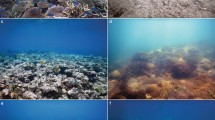Abstract
Fish ecologists need to do pilot studies to develop accurate, precise and efficient sampling strategies. This paper presents a case study of the pilot investigations carried out to achieve this for three species of butterflyfish Chaetodon rainfordi, C. plebeius and Chelmon rostratus, at One Tree Reef. The effects of different transect sizes and methods on density estimates and their precision for each species were assessed. Varying transect dimensions (25, 50, 75 and 100 m lengthx1,2 and 3 m width) did not significantly affect the density estimates. However for C. rainfordi the precision of estimates was variable with the smallest transect length and width producing the least precise results. Higher density estimates were obtained for juvenile fish over a 1 m strip width than a 2 m width. A significant effect of disturbance on the densities of C. rainfordi and Chelmon rostratus was caused by the laying out of the transect tape. Consequently a technique of simultaneously censusing and delimiting transect boundaries was tested and found to give consistently higher density estimates. The potential effect of censusing at different times of the tide was examined and found to be insignificant for two species but quite complex for the other. Finally, a pilot sampling program was done at seven localities across One Tree Reef to determine the most efficient way of allocating sampling effort, for future census work.
Similar content being viewed by others
References
Anderson DR, Pospahala RS (1970) Correction of bias in belt transect studies of immotile objects. J Wildl Manage 34:141–146
Boer BA de (1978) Factors influencing the distribution of the damselfish Chromis cyanea (Poey), Pomacentridae, on a reef at Curacao, Netherlands Antilles. Bull Mar Sci 28:550–565
Brock VE (1954) A preliminary report on a method of estimating reef fish populations. J Wildl Manage 18:297–308
Brock RE (1982) A critique of the visual census method for assessing coral reef fish populations. Bull Mar Sci 32:269–276
Caughley G, Sinclair R, Scott-Kemmis D (1976) Experiments in aerial survey. J Wildl Manage 40:290–300
Chave EH, Eckert DB (1974) Ecological aspects of the distributions of fishes at Fanning Island. Pac Sci 28:297–317
DeMartini EE, Roberts D (1982) An empirical test of biases in the rapid visual technique for species-time censuses of reef fish assemblages. Mar Biol 70:129–134
Doherty PJ (1980) Biological and physical constraints on the populations of two sympatric damelfishes on the southern Great Barrier Reef. PhD thesis. Sydney University
Doherty PJ (1983) Tropical territorial damselfishes: is density limited by aggression or recruitment? Ecology 64:176–190
Eckert GJ (1985) Population studies on Labrid fishes on the Southern Great Barrier Reef. PhD thesis, Sydney University
GBRMPA (1978) Great Barrier Reef Marine Park Authority workshop on reef fish assessment and monitoring. Workshop series no 2. GBRMPA, Townsville, Australia
Hobson ES (1974) Feeding relationships of Teleostean fishes on coral reefs in Kona, Hawaii. Fish Bull 72:915–1031
Jones GP (in press) Competitive interactions among adults and juveniles in a coral reef fish. Ecology (in press)
Jones RS, Chase JA (1975) Community structure and distribution of fishes in an enclosed island lagoon in Guam. Micronesica 11:127–148
Jones RS, Thompson MJ (1978) Comparison of Florida reef fish assemblages using a rapid visual technique. Bull Mar Sci 28:159–172
Keast A, Harker J (1977) Strip counts as a means of determining densities and habitat utilization patterns in lake fishes. Environ Biol Fish 1:181–188
Kennelly SJ, Underwood AJ (1984) Underwater microscopic sampling of a sublittoral kelp community. J Exp Mar Biol Ecol 76:67–78
Kimmel JJ (1985) A new species-time method for visual assessment of fishes and its comparison with established methods. Environ Biol Fish 12:23–32
McCormick MI (1986) Spatial and temporal pattern of abundance of Cheilodactylus spectabilis (Pisces: Cheilodactylidae). MSc thesis, Auckland University
Robertson DR, Lassig B (1980) Spatial distribution patterns and coexistence of a group of territorial damselfishes from the Great Barrier Reef. Bull Mar Sci 30:187–203
Robinette WL, Loveless CM, Jones DA (1974) field tests of strip census methods. J Wildl Manage 38:81–96
Russell BC, Talbot FH, Anderson GRV, Goldman B (1978) Collection and sampling of reef fishes. In: Stoddart DR, Johannes RE (eds) Monographs on oceanographic methodology, vol 5: Coral reefs: research methods. UNESCO, Norwich, UK, pp 329–345
Sale PF (1974) Mechanisms of co-existence in a guild of territorial fishes at Heron Island. Proc 2nd Int Coral Reef Symp 1:193–206
Sale PF, Douglas WA (1981) Precision and accuracy of visual census technique for fish assemblages on coral patch reefs. Environ Biol Fish 6:333–339
Sale PF, Sharp BJ (1983) Correction for bias in visual transect censuses of coral reef fishes. Coral Reefs 2:37–42
Sale PF, Doherty PJ, Eckert GJ, Douglas WA, Ferrell DJ (1984) Large scale spatial and temporal variation in recruitment to fish populations on coral reefs. Oecologia 64:191–198
Sale PF, Jones GP, Choat JH, Leis JM, Thresher RE, Williams DMcB (1985) Current priorities in ecology of coral reef fishes. Search 16:270–274
Sanderson SL, Solonsky AC (1980) A comparison of two visual census survey techniques for fish populations. Pac Sci 34:337
Snedecor GW, Cochran WG (1967) Statistical methods, 6th edn. Iowa State University Press, Ames, Iowa
Stone RB, Pratt HL, Parker RO Jr, Davis GE (1979) A comparison of fish populations on an artificial and natural reef in the Florida Keys. Mar Fish Rev 41:1–11
Victor BC (1983) Recruitment and population dynamics of a coral reef fish. Science 219:419–420
Underwood AJ (1981) Techniques of analysis of variance in experimental marine biology and ecology. Oceanogr Mar Biol Annu Rev 19:513–605
Author information
Authors and Affiliations
Rights and permissions
About this article
Cite this article
Fowler, A.J. The development of sampling strategies for population studies of coral reef fishes. A case study. Coral Reefs 6, 49–58 (1987). https://doi.org/10.1007/BF00302212
Accepted:
Issue Date:
DOI: https://doi.org/10.1007/BF00302212




